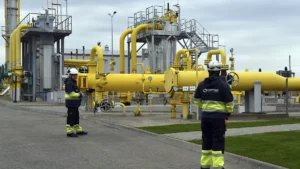Natural gas futures have sunk to their lowest inflation-adjusted prices since they began trading on the New York Stock Exchange in 1990.
This drop is largely due to the United States’ high production rates and a warmer winter, which have pushed prices down.
Beneficial for US consumers and industries reliant on natural gas for steel, concrete, cardboard, and fertilizer production.
However, this price decline poses challenges for gas producers, prompting a reduction in drilling activities and a push for increased exports to mitigate the domestic surplus.
As of last week, March delivery futures fell to $1.603 per MMBtu, a 35% decrease from the previous year, hitting an inflation-adjusted all-time low of $1.576 on Tuesday.

These methods often led to an oversupply in the market, causing prices to drop sharply.
Current U.S. daily production has slightly decreased from its December peak but is still up 3.3% from last February.
Chesapeake and other producers cut spending and production for 2024 amid low demand and high storage levels.
Chesapeake’s strategy includes drilling without completing wells, keeping the gas underground until prices rebound.
Decision reflects industry expectation: prices may rise late 2024 and 2025 with new LNG export terminals opening.

